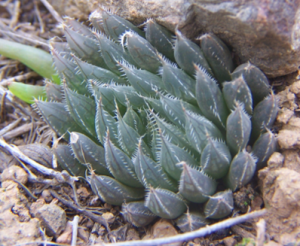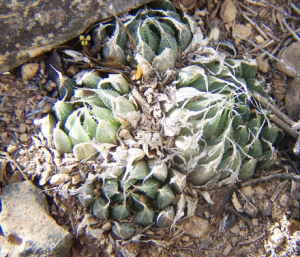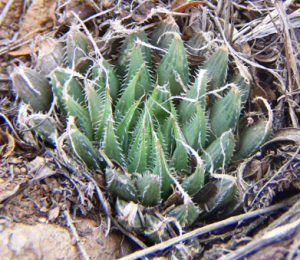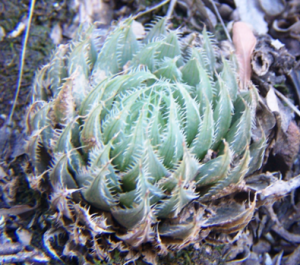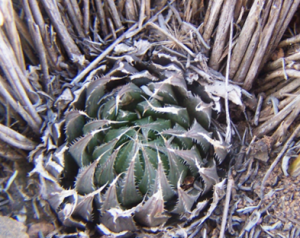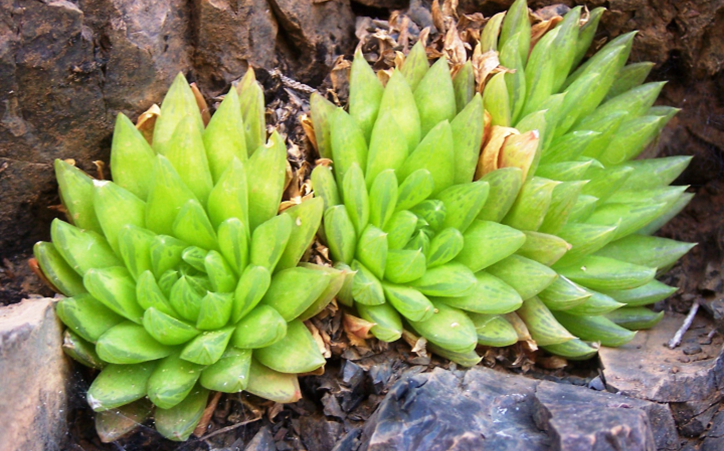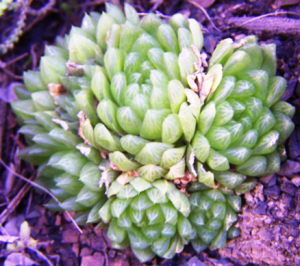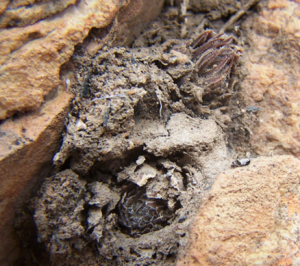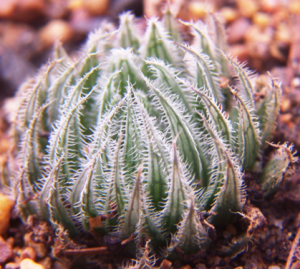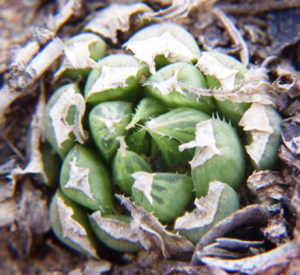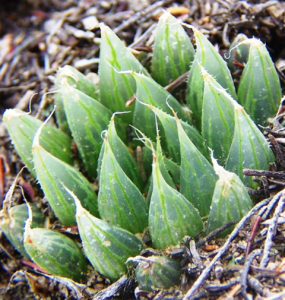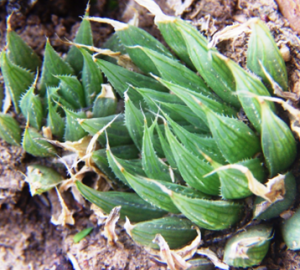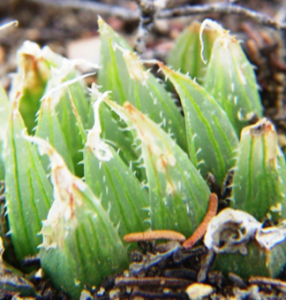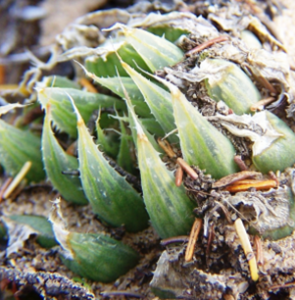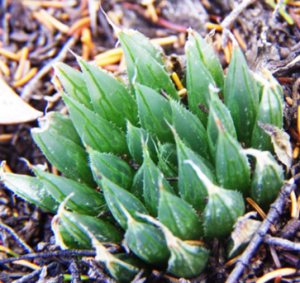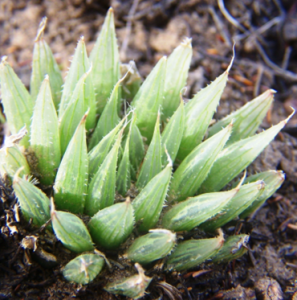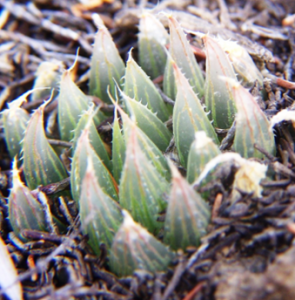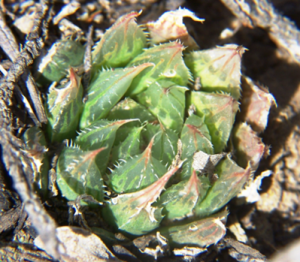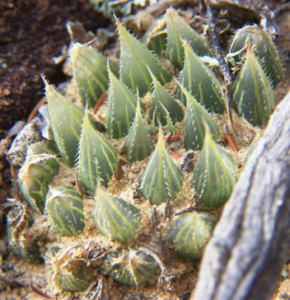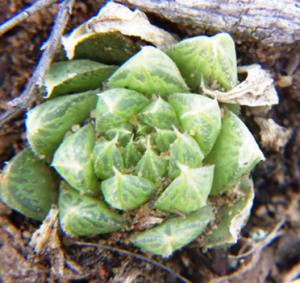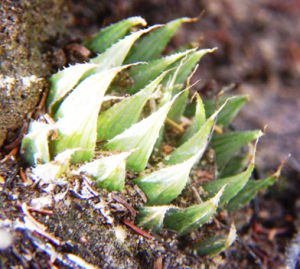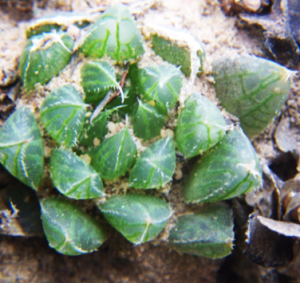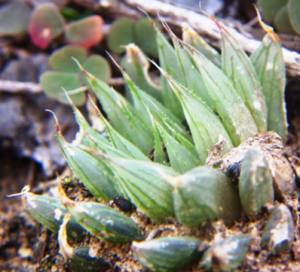Part 1.
Kaboega is a set of farms on the northeast of the Zuurberg Mountain range, north of Kirkwood and off the Addo National Park. I wrote about the haworthias that occur there in Haworthia Update Vol.1. There is also an article in Aloe 40:10 (2003) in which there is a discussion of the variation of those haworthias as related to geology and topography. My wife and I frequently visit Kaboega to renew relationships with Ian and Sandy Ritchie who live there. Each time we go we try to explore some different area. We generally end-up with something that is notably new.
There is a real problem in trying to reconcile the populations we see with the names that are available and the way in which I have tried to formalize them myself. The problem is that Kaboega seems to occupy some sort of central and neutral position and it is by no means easy to arrive at any clean rational classification. Three of my species are involved, and I have to say they are “mine” because other authors are in strong disagreement. The three species I see are H. cymbiformis, H. cooperi, and H. aristata. It is firstly necessary to explain that I interpret the name H. aristata in Haworthia Revisited quite differently from what I might have done earlier; and quite differently from other authors who have simply taken the easy route and associated the name with Little Karoo elements for which I use the name H. mucronata. My interpretation of the name will be quite evident from my writings and from the pictures submitted with this article. The use of the name H. cymbiformis with respect to Kaboega is a major problem for someone like myself who is firmly convinced that geographical relationships are foremost in the recognition of species as living systems. On Kaboega, plants that look like H. cymbiformis seem to proceed out of a complex that is surely H. cooperi. If one properly considers all the populations that I ascribe to H. aristata one is seriously confronted with the reality that it is also a geographic variant of H. cooperi.
During June 2008 we were again at Kaboega and found two further populations of ostensible H. aristata. One of these viz. MBB7698 (see figs 1a-d) is only about 1km east of Buffelsnek on the western boundary where I recorded MBB7012. We did also see the same plants on a ridge still further east and north of Wilgerfontein where the very green and proliferous cymbiformis-like plants seem to reach their western limit. MBB7698 is effectively on the top of the Spekboomberg ridge, whereas the cymbiformoids are a little to the west and on the south slopes. It would be really interesting to know what occurs further westwards towards Darlington Dam.
We found H. aristata again practically central to the farm and about 1,5km south east of the Weir (MBB7703, see figs 2a-c, and these plants may have been illustrated before elsewhere incorrectly as MBB7697, a Gasteria). This is still about 1km north of the east-facing riverine cliff that houses the very green cymbiformoid plants (MBB7636, see figs 3a-c) of which other populations have already been reported to the east at De Plaat (3 populations) and also to the west at Koks Dam and Spekboomberg.
I have probably argued for recognition of H. aristata as separate from H. cooperi. Such an entity can probably be recognized as occupying the lowlands to the north of the Zuurberg. Both H. cooperi and H. bolusii var. pringlei occur to the north at Ripon and it appears that the latter may be represented by a population northeast of Stonefountain. There is a problem with proper, as opposed to the formal way either Breuer or myself may have done typification of the name H. gracilis, where we have both apparently just guessed that the name applies to the Helspoort variants of H. cooperi. In fact von Poellnitz’ name H. gracilis rest on the citation of a really mixed bag from not just Hellspoort, but from five quite disparate locations across almost the entire Cape. I use the name ‘gracilis’ only in reference to Hellspoort and it is evident to me that H. aristata is in the H. cooperi continuum. Look at the pictures and see what you think. I have added three pictures (MBB7701, see Figs 4a-c) taken of plants above Klipfontein at the eastern end of Kaboega that I refer to as H. cooperi ‘puberula’ and related to another record MBB6908 at Wilgerfontein.
Part 2.
Variants of H. cooperi on Kaboega
The various populations of H. cooperi are discussed or referred to in several of my essays published in the Haworthia Updates and elsewhere. I have also been privileged to go back to Kaboega several times and further explore there. Each visit generates something new and different and evokes thoughts of what is still unseen, unreported and unknown.
On this occasion Daphne and I were actually hoping to find and photograph perhaps a chameleon, as workers had reported seeing one abut six months previously in the vicinity of the Klipfontein guest house on Kaboega. This is in the northeastern end of the set of farms that now constitute Kaboega. We thought we should explore the upper slopes where there was more sunlight and basking opportunity for the chameleons in the cold winter sun.
We climbed up the mountain via a very overgrown route that served as a passage for stock to access the higher mountain slopes, but also serve as a donkey pack route for the transport of supplies over the mountain in earlier days. This is of course peripheral to plant exploration. Nevertheless it is so fascinating to dwell on the fact that the enlarged game farm is actually comprised of about seven smaller farms that once were home to farmers and family. All abandoned as circumstances have changed over the years. It is as though man invaded this rich treasure house of natural beauty, sucked it dry and abandoned it again leaving nature to now heal the wounds. This is very unlikely because of the game fences and the absence of predators. Rainfall is marginal and the Kudu population is huge. Nature will have to respond in some dramatic and drastic way if she has anything in mind, and she is perfectly capable of that.
We moved east of our original visit to the mountain top where we had seen and photographed a few scattered plants before. We know that if we find one plant, to ask “Now where are they?” This confinement to such discrete, small habitats is so characteristic that we laugh off the notion that to explain the vicarious distributions over great distance, the plants were wider spread at some distant time in the past. Something else is at work and these populations maintain pattern and coherence beyond material means.
Eventually Daphne, whose eyes are now better than mine, did find the first plant and the body of the population we had only touched before. So these are the pictures. The first three pictures are of MBB6901 H. aristata (See figs 5a-c) on the lower country north of the mountain about 3km away on a neighbouring farm Doornkloof, the next one would be a cultivated plant of MBB7701 H. cooperi ‘puberula’ nom nud (See fig. 6) in sandstone and Fynbos vegetation in the mountain south of Klipfontein. The rest are H. cooperi (no appellation – MBB6940, See figs 7a-p) just east of my previously reported site north of Klipfontein, also in sandstone and transitional Fynbos. This term is used to simply imply one of these strange anomalies where karoid and Fynbos elements mingle. Many more pictures are really needed to indicate that each plant looks different and we spent a long and enjoyable time calling back and forth to come and observe one more gem.
Some of the clones would correspond to clones in the parent population of H. cooperi ‘viridis’ at Perdepoort about 20km west while others to H. cooperi ‘gracilis’ from Helspoort north of Grahamstown, 50km east. Thus to my mind there is no satisfactory solution to the naming of these plants in our conventional understanding of Latin names.
The last photograph is a view across the Klipfontein valley and over the old greater farmyard to a mountain ridge and over that to the Zuurberg Mountain itself. Between is the Vyeboomfontein farm. The black arrows mark a point on the near ridge where there is a Bushman painting site and a large quartz rock that is home to plants like MBB7101. That mountain ridge extends westward 1-2km to the abandoned DePlaat farmhouse where there are again populations of H. cooperi on northwest and south aspects, at different altitudes and with their own variants. More conventional H. cooperi ‘pilifera’ can be found on the far mountain while Kaboegapoort is a gorge through the mountain with still another set of populations and variants.
It is all a wondrous never ending drama.
Part 3.
General comments on the plants on Kaboega.
The southern end of Africa is home to one of the six or seven plant kingdoms of the world. This is the so-called Cape Floral Kingdom. Botanists in the past seem to have misinterpreted this flora and not realized that it maintains its integrity for two reasons. The first is that it is on the table Mountain Sandstone formation and the second is that it is in a winter rainfall zone. Its origins are no doubt ancient, but in present day terms it is part of a present day winter rainfall area which includes the Succulent Karoo. Kaboega sits on the eastern verge of this biome and is therefore in a huge tension zone between inland, upland, summer and winter rainfall (and the stress of dryness) vegetation groupings.
Apart from annual rainfall stresses, broken topography, skeletal soils and an enormous range of exposed geological formations and rock series, contribute to an extraordinary range of varied habitats. Thus South Africa and especially the Cape, offer plant species huge opportunities to adapt and change according to ecological differences and stresses. Kaboega is a wonderful example of the way in which plant species have adapted to these different habitats.
Kaboega has plant species from all of the biomes in the Cape, and the vegetation ranges from upland grassy fynbos, renosterveld, succulent karoo, valley bushveld and countless variation of these. The main rocks are quartzitic, dwyka tillite (of glacial origin) and shales. In addition there is a small amount of alluvial terrace.
What is so dramatic is that the different species occupy sometimes very limited habitats and despite this tight habitat choice (requirement) it is very difficult to specify what those requirements are for any group of species.
The genus Haworthia is represented by two of its subgenera. The Subg. Hexangulares is represented by three species:-
a. H. glauca, which is present mostly on the upper quartzitic ridges where Euphorbia polygona and the asclepiad Huernia brevirostris occur. This form of H. glauca includes some evidence of apparent interaction with H. coarctata which comes from further east.
b. H. sordida is an isolated population south of the Zuurberg and then westwards to Steytlerville. It was known on Kaboega from only one small hill where it grew under renoster bush. It was only while researching this visit that a second group was found.
c. H. nigra, which is very widespread in the greater karoo, but rare this far south and so far it is only known from one small population on the river terrace gravels.
The second subgenus Haworthia is only represented by many varieties of but one species viz. H. cooperi and this recognition of one species is only arrived at by discarding the traditional view of plant taxonomy that has no definite and decisive definition for the word species. The Kaboega plants are known from about 30 populations. These vary dramatically, but continuously, according to habitat and this has to be considered in terms of continuing similarities from Kaboega outwards into the Karoo, the Western Cape and the Eastern Cape. This suggests that there are very complex species systems and species cannot be as easily identified and described by visible characters, as a loose definition has in the past allowed. The Kaboega populations are very different from each other, and could be said to be from four or more species if fancy rules. In fact they are probably adapted by habitat and are evidence of the continuity of them all in one species complex.
It is population structure which is so significant and if one considers all the plant species that occur on Kaboega, one comes to realize that they occupy often unique habitats. There is one level of generalists such as Acacia karoo, Olea africana, Aloe ferox, etc which seem to be ubiquitous. But actually most of the species can be seen to have a “home”. There are about seven species of Aloe on Kaboega and seldom do more than two share habitat. As one goes through a general list of names, one finds that one has to visit very specific places to find the plants. One can also find places like this one spot at Klipfontein that can be described as a “hotspot” for Kaboega. These are small species rich areas, which host species which do not occur generally and may in fact be very rare for Kaboega. By also occurring on Kaboega like this, they represent a genetic entity and resource which may be quite unique
Acknowledgement.
I am most grateful to Ian and Sandra Ritchie for their generous hospitality and interest for the many times and hours we have spent fossicking in the wilderness of Kaboega.


